Saludos Cordiales apreciada Comunidad Hive, deseo gran bienestar para todos, así como a @rutablockchain, a @esency y a los canalizadores y orientadores de Hive, @danielvehe, @enmymente y @ambarvegas mi respeto y agradecimiento por permitirme este especial espacio en la plataforma. Les presento mi nuevo post, en el cual describo bajo mis criterios de formación en la temática que me apasiona, las relaciones que existen entre la musicalidad y la religiosidad africana ancestral y actual, como caracteres muy vinculados, enraizados con sus expresiones culturales y por ende, sus formas de vida.
Cordial Greetings appreciated Hive Community, I wish great welfare for all, as well as @rutablockchain, @esency and Hive channelers and counselors, @danielvehe, @enmymente and @ambarvegas my respect and gratitude for allowing me this special space on the platform. I present my new post, in which I describe under my training criteria in the subject that I am passionate about, the relationships that exist between musicality and ancestral and current African religiosity, as closely linked characters, rooted with their cultural expressions and therefore, their ways of life.
Todas las sociedades pasan por procesos de evolución desde sus orígenes. Durante los cuales se van adecuando y adaptando a las condiciones ambientales del contexto en el cual les correspondió vivir, superar niveles de subsistencia y avanzar en crecimiento y desarrollo, para lograrlo necesariamente el hombre ha debido y debe crear todo lo necesario para alcanzar esos fines tales como patrones de vida, instrumentos y elementos que le faciliten y los identifiquen. En ese concepto amplio de adaptación, se define al Hombre como Creador de Cultura.
All societies go through processes of evolution from their origins. During which they adapt and adapt to the environmental conditions of the context in which they have to live, overcome subsistence levels and advance in growth and development. To achieve this, man has necessarily had to create and must create everything necessary to achieve these goals, such as life patterns, instruments and elements that facilitate and identify them. In this broad concept of adaptation, Man is defined as the Creator of Culture.
La Cultura en sus diferentes expresiones, manifestaciones y connotaciones, tanto material como inmaterial, va a depender de su ubicación en la línea del tiempo y el espacio geográfico. En ese tránsito ha buscado de encontrar el significado de los que le rodea y aquello que no descifra o no entiende les infunde como sociedad temor a lo desconocido, respeto, incertidumbre. Esta condición en las sociedades primitivas generó el hecho que se otorgaran condiciones de dioses o semi dioses a aquellos fenómenos naturales que no podían explicar pero que determinaban sus patrones de vida: el sol, las lluvias, la luna, ríos, animales sagrados y veneración o culto a sus antepasados, a quienes debían mantenerlos bien atendidos, pues de lo contrario, se convertirían en entes malignos.
Culture in its different expressions, manifestations and connotations, both material and immaterial, will depend on its location in time and geographic space. In this transit it has sought to find the meaning of what surrounds it and that which it does not decipher or does not understand instills fear of the unknown, respect, uncertainty in society. This condition in primitive societies generated the fact that they granted conditions of gods or semi-gods to those natural phenomena that they could not explain but that determined their patterns of life: the sun, the rains, the moon, rivers, sacred animals and veneration or worship to their ancestors, whom they had to keep well cared for, otherwise, they would become evil entities.
La naturaleza, sus fenómenos, culto a los ancestros y el uso del verbo (palabra) representaron el inicio de los aspectos mágico religiosos. En éste sentido en África y en especial la subsahariana, en función de ese respeto a lo desconocido esos fenómenos naturales fueron considerados dioses, semi dioses, deidades, fuerza, lo cual alimentó una Visión Cosmogónica Animista, ya que se les atribuía alma, vida, energía. Hodge, Ileana. Reencuentro de Tradiciones Ancestrales. La Habana, 2012.
Nature, its phenomena, ancestor worship and the use of the verb (word) represented the beginning of the magical-religious aspects. In this sense, in Africa and especially in sub-Saharan Africa, as a function of this respect for the unknown, these natural phenomena were considered gods, demi-gods, deities, force, which fed an Animist Cosmogonic Vision, since they were attributed soul, life, energy. Hodge, Ileana. Reencuentro de Tradiciones Ancestrales. Havana, 2012
La Cosmogonía Africana se caracterizaba y se caracteriza, aún en algunos sectores con rasgos primitivos, de poseer una narrativa mitológica a través de la cual, explican el origen del Universo y de la Humanidad misma atribuyendo cuotas de participación a sus deidades. Esta información ha sido inferida por investigadores quienes contrastan datos arqueológicos, antropológicos etnográficos que han logrado registrar con los datos obtenidos por la vía de la oralidad, tomadas de sociedades actuales nombrando algunas como la mbuti, lugbara, batube, hausa, lokuto, zulu, mursi, tuareg, masai, entre muchas otras, MARQUEZ, Aníbal. Embajador de Venezuela en la República del Congo.
The African Cosmogony was and is characterized, even in some sectors with primitive features, of possessing a mythological narrative through which they explain the origin of the Universe and of Humanity itself, attributing quotas of participation to their deities. This information has been inferred by researchers who contrast archaeological, anthropological and ethnographic data that they have been able to record with the data obtained orally, taken from current societies such as the Mbuti, Lugbara, Batube, Hausa, Lokuto, Zulu, Mursi, Tuareg, Masai, among many others, MARQUEZ, Aníbal. Ambassador of Venezuela to the Republic of Congo.
-_________________________________________________________________
Se les otorga particularidad a cada expresión religiosa contextualizada, por ello no podemos afirmar que exista una sola Religión en África, sino de religiosidades y posturas religiosas, con algunas condiciones comunes como la animación de elementos naturales, en función de lo cual, se les identifica como politeístas y para recibir beneficios, realizaban y algunas realizan prácticas de ceremonias y rituales con cultos hacia sus antepasados, donde la palabra o el canto cumplen una función significativa ya que contienen y emiten energía. Han variado con el tiempo pero siempre acompañados por música y bailes, en caso de ceremonias, bailes sagrados o consagrados.
Each contextualized religious expression is given particularity, therefore we cannot affirm that there is only one Religion in Africa, but of religiosities and religious postures, with some common conditions as the animation of natural elements, in function of which, they are identified as polytheists and to receive benefits, they carried out and some carry out practices of ceremonies and rituals with cults towards their ancestors, where the word or the song fulfill a significant function since they contain and emit energy. They have varied over time but always accompanied by music and dances, in the case of ceremonies, sacred or consecrated dances.
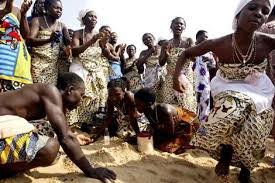
Ceremonia Africana.hablemosdemitologias.com.
La Música expresada a través de los toques musicales con baterías de tambores consagrados, se les concede el carácter de hilo conductor de las conversaciones entre dioses y de éstos con los hombres. La religiosidad animista africana “abarca, la fe en la divinidad, la capacidad de leer el futuro, aspectos mágicos, creencia en energías presentes buenas o no, el politeísmo, hierbas medicinales ancestrales, comida a la tierra (a los ancestros), la fuerza de la palabra, los ebbo, los sacrificios de animales”. Movimientos Afroreligiosos. Padrino Yroso Fum.
The Music expressed through the musical touches with consecrated drums, they are granted the character of conductive thread of the conversations between gods and of these with the men. The African animist religiosity "includes, the faith in the divinity, the capacity to read the future, magical aspects, belief in good or not present energies, polytheism, ancestral medicinal herbs, food to the earth (to the ancestors), the force of the word, the ebbo, the animal sacrifices". Afroreligious movements. Godfather Yroso Fum.
Debido a lo anterior expuesto me atrevo a afirmar que en África, la religiosidad y las expresiones musicales, surgieron de la mano.
Due to the above, I dare to affirm that in Africa, religiosity
and musical expressions emerged hand in hand.
Las razones para entretejer en mi narrativa lazos vinculantes entre el pasado y el presente, las fundamento en La Máxima Filosófica Nigeriana de Anayanwu, quien de manera indirecta, explica lo anterior con su definición de filosofía africana como “aquella que se preocupa por la forma en la cual los africanos del pasado, dan forma y sentido al destino del mundo en el cual viven los africanos del presente”.
The reasons for nterweave in my narrative binding ties between the past and the present, I base them on Anayanwu's Nigerian Philosophical Maxim, who indirectly explains the above with his definition of African philosophy as "that which is concerned with the way in which Africans of the past, give shape and meaning to the destiny of the world in which Africans of the present live".
Este principio filosófico de Anayanwu lo evidenciamos cuando observamos el esfuerzo de la africanidad actual y descendientes quienes buscan preservar lo que aún mantienen en cuanto a información de su pasado para implementar en su vida activa. De acuerdo a este principio se estima que las sociedades africanas se han comportado así tanto ayer como hoy. Hodge, Ileana. Op. Cit.
This philosophical principle of Anayanwu is evidenced when we observe the efforts of current Africans and their descendants who seek to preserve what they still maintain in terms of information from their past to implement in their active life. According to this principle, it is estimated that African societies have behaved this way both yesterday and today. Hodge, Ileana. Op. cit.
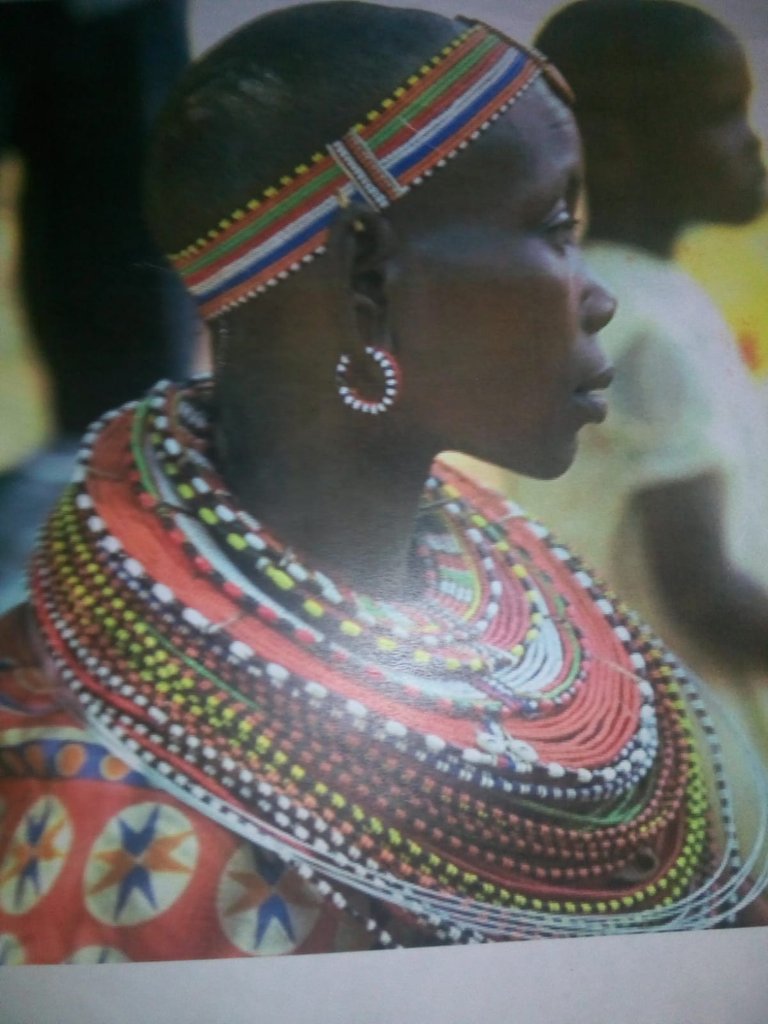
Mujer de Sudan previa Ceremonia.Foto Anibal Márquez.Woman of Sudan prior to the Ceremony.Photo Anibal
La filosofía nigeriana acuña de manera implícita, una transmisión intergeneracional de información, que se puede correlacionar con una normativa ética ZULU, que existe en comunidades sudafricanas basada en una regla ética de LEALTAD entre las personas con las cuales se convive y se inter relacionan.
The Nigerian philosophy implicitly coined an intergenerational transmission of information, which can be correlated with a ZULU ethical norm that exists in South African communities based on an ethical rule of LOYALTY among people with whom they live and interrelate
Ésta normativa ética Zulu, es el UBUNTU:
“Soy porque Somos”
“Yo existo porque tu existes, y porque Yo existo, Tu existes”
This Zulu ethical norm is UBUNTU:
"I am because We are".
"I exist because you exist, and because I exist, you exist".
El Ubuntu es una invitación a la vida social característica africana, que rige la VIDA en comunidad, en tribus de los africanos y regula además de su vinculación con el pasado, la convivencia social INTERNA basada en la confianza entre sus miembros, en el compartir, en el respeto, en el resguardo de todo, porque a TODOS pertenece, incluso expresiones religiosas musicales; no se concibe la vida desde el individualismo, desde lo personal, todo se realiza en ambientes de generosidad y solidaridad, tanto así que en algunas tribus se practica la poliandria y la poligamia como formas de unidad familiar.
The Ubuntu is an invitation to the African characteristic social life, which governs the LIFE in community, in tribes of Africans and regulates besides its link with the past, the INTERNAL social coexistence based on the confidence among its members, in the sharing, in the respect, in the safeguard of everything, because it belongs to ALL; life is not conceived from individualism, from the personal, everything is done in environments of generosity and solidarity, so much so that in some tribes polyandry and polygamy are practiced as forms of family unity.
Bajo este contexto referido, la religión animista africana se realiza en ceremonias y rituales comunitarios, incitados por la musicalidad y sonoridad de los tambores, la cual, como manifestación socio cultural, simboliza las conversaciones entre los tambores y los dioses, las conversaciones entre ellos y de ellos con los hombres: para el africano y descendiente, la Música del TAMBOR simboliza la conexión del hombre con sus dioses.
Under this context, the African animist religion is performed in ceremonies and community rituals, incited by the musicality and sonority of the drums, which, as a socio-cultural manifestation, symbolizes the conversations between the drums and the gods, the conversations between them and between them and men: for the African and his descendants, the DRUM MUSIC symbolizes the connection of man with his gods.
Con todo lo anterior pretendo explicar la razón por la cual los toques de tambor africano y descendientes, sus cantos y bailes son la mayoría grupales, ya que por provenir de la normativa comunitaria “compartir” del Ubuntu, las fuentes animistas aumentan sus energías por medio del canto e incrementan la FE de sus seguidores.
With all the above I intend to explain the reason why the African drumming and descendants, their chants and dances are mostly group-based, since coming from the communal "sharing" rules of Ubuntu, the animist sources increase their energies through chanting and increase the FAITH of their followers.
Realizando la anterior aproximación a los orígenes de la religiosidad y musicalidad afrovenezolana, también considero que no tenemos criterios para juzgarla con calificativos como espeluznantes, oscura, sorprendente, e incluso he oido, satánica.Como ya antes mencioné, cada sociedad tiene su particular forma de adaprarse a su medio, en éste caso, las sociedades africanas lo han hecho sencillamente de acuerdo a su interpretación y visión animista sobre elementos naturales y sus antestros. Lo que quiero decir con esto, es que desde posiciones o contextos externos no tenemos elementos para juzgar,evaluar ninguna portura religiosa, en éste caso, la africana, y menos cuando esta parte sencillamente de culto a elementos animados.
In the previous approach to the origins of Afro-Venezuelan religiosity and musicality, I also consider that we do not have criteria to judge it with adjectives such as creepy, dark, surprising, and I have even heard, satanic, as I mentioned before, each society has its particular way of adapting to its environment, in this case, African societies have done it simply according to their interpretation and animist vision of natural elements and their ancestors. What I mean by this is that from external positions or contexts we have no elements to judge, to evaluate any religious culture, in this case, the African one, and even less when it is simply part of the cult of animated elements.
El Tambor africano llegó a las Indias Occidentales durante la conquista y colonización, los esclavizados llegaron a América desposeídos de TODO, menos de su conciencia y con ella sus recuerdos, afectos, contenidos culturales, religiosos, musicales.
The African Drum arrived to the West Indies during the conquest and colonization, the enslaved people arrived to America dispossessed of EVERYTHING, except their conscience and with it their memories, affections, cultural, religious, musical contents.
Ya en América, a la condición animista de la religiosidad accionados por beneficios colectivos, se les suma una razón social: sus deseos de recuperar LA LIBERTAD, que les fue arrebatada al ser secuestrados como esclavizados. Sin nada material, nada más que su conciencia, sus recuerdos permitieron reanimar en América, la vida religiosa, cultural, musical de África; cualquier elemento les servía para emitir sonoridad o en el mejor de los casos eran construidos para expresarse.
Already in America, to the animist condition of the religiosity driven by collective benefits, a social reason is added: their desires to recover FREEDOM, which was taken away from them when they were kidnapped as slaves. With nothing material, nothing more than their conscience, their memories allowed to revive in America, the religious, cultural, musical life of Africa; any element served them to emit sonority or in the best of the cases they were built to express themselves.
La sonoridad de los tambores ya en América, avanzada la colonización también fue utilizada para conocer la ubicación de otros asentamientos afrodescendientes y de esclavizados, surgimiento, identificación y acciones de Cimarrones o potenciales Cimarrones y sus Cumbes en Venezuela, para en conjunto organizar posibles alzamientos y/o rebeliones. Por ésta razón la Iglesia Católica, blancos peninsulares y blancos mantuanos prohibieron en Venezuela el uso y toque de tambores, para evitar la comunicación a distancia entre los esclavizados.
The sonority of the drums already in America, advanced the colonization was also used to know the location of other Afro-descendant settlements and enslaved, emergence, identification and actions of Maroons or potential Maroons and their Cumbes in Venezuela, to jointly organize possible uprisings and / or rebellions. For this reason the Catholic Church, peninsular whites and Mantuan whites prohibited the use and playing of drums in Venezuela, to avoid distant communication among the enslaved.
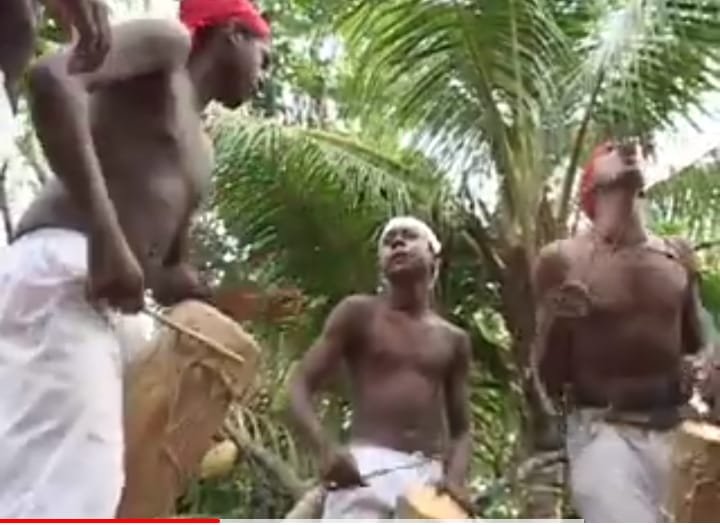
Jóvenes Curieperos tocando el culo é puya.Young Curieperos playing the ass and puja.
El toque de TAMBOR en América fue símbolo de vínculos con elementos de dimensiones sobrenaturales y hoy en día algunos continúan siéndolo. La sonoridad musical de los tambores, AFLORAN en América, obviamente, no como una imposición, al contrario por la vía de la sumisión, del sentimiento popular, sus deseos libertarios constantes y por ser música de esclavizados, debían mantenerlos en la clandestinidad. Donde hubo esclavizados africanos, hubo tambores y bailes humildes. Sus distintas tonalidades expresaban el contenido y ánimo de la comunicación.
The drumming in America was a symbol of links with elements of supernatural dimensions and today some of them continue to be so. The musical sonority of the drums, AFLORAN in America, obviously, not as an imposition, on the contrary by way of submission, of popular sentiment, their constant libertarian desires and for being music of enslaved people, they had to keep them in clandestinity. Where there were enslaved Africans, there were drums and humble dances.Their different tonalities expressed the content and mood of the communication.
Durante la colonia, se mantuvo como constante la musicalidad del TAMBOR, pero excluidos, execrados de la sociedad de castas, ya que por ser música de negros “eran oficios bajos y no de honra, de negros, de gentes viles y ritos paganos, inspirados por el demonio” BARRIGA, Martha Lucía. La Historia del Tambor Africano y su Legado en el Mundo.
During the colony, the musicality of the DRUM was maintained as constant, but excluded, execrated of the caste society, since for being music of blacks "they were low trades and not of honor, of blacks, of vile people and pagan rites, inspired by the demon" BARRIGA, Martha Lucía. The History of the African Drum and its Legacy in the World.
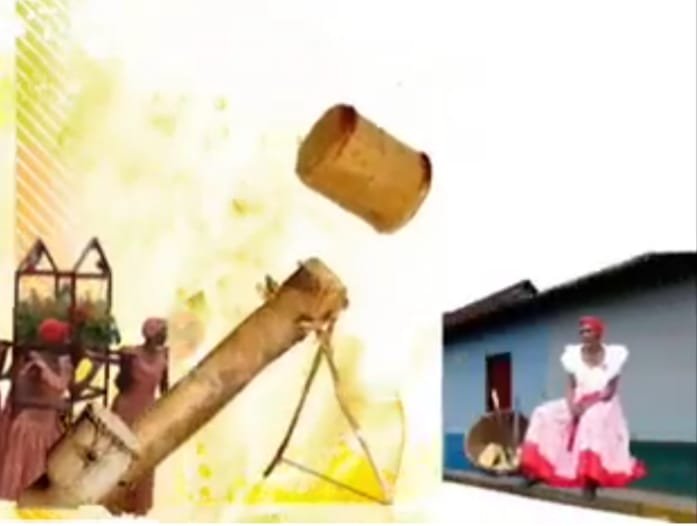
Curiepe Tambores Gritos de Libertad. Madera Presenta. Noel Márquez.
La negación del criterio animista de la religiosidad y cultura de los africanos esclavizados, resultó con la imposición de criterios y argumentos católicos, Santos, festividades, etc., que éstos debían acatar aunque no abandonaron las creencias en sus deidades ni las dimensiones de su religiosidad y comunicación.
The denial of the animist criteria of the religiosity and culture of the enslaved Africans resulted in the imposition of Catholic criteria and arguments, Saints, festivities, etc., which they had to abide by, although they did not abandon their beliefs in their deities nor the dimensions of their religiosity and communication.
En base a lo anterior, en lo socio-cultural, se produjo en muchos casos a.- el paralelismo: cuando una cultura no se impone de manera invasiva en los caracteres de otra aparentemente sumisa, caminan juntas pero no se vinculan. Este aspecto ha permitido que muchos asentamientos afros aún conserven rasgos primitivos de su ancestralidad; en otros casos, b.- la transculturación y el sincretismo que sí implicó e implica la invasión bidireccional de los contenidos resultantes en híbridos y corren el riesgo que las referencias africanas caigan al olvido, ante el surgimiento de otras variedades.
Based on the above, in the socio-cultural aspect, in many cases a.- parallelism was produced: when a culture does not impose itself in an invasive way on the characters of another apparently submissive one, they walk together but do not link up. This aspect has allowed many Afro settlements to still conserve primitive features of their ancestry; in other cases, b.- transculturation and syncretism that did imply and implies the bidirectional invasion of the resulting contents in hybrids and run the risk that the African references fall into oblivion, before the emergence of other varieties.
Puedo afirmar que durante ese tránsito evolutivo de la musicalidad de los tambores africanos durante el período colonia,l se produjo la división de la misma en tres vertientes desde hace relativamente poco tiempo, podría decir que a inicios del siglo XX.
I can affirm that during this evolutionary transit of the musicality of the African drums during the colonial period, there was a division of it in three aspects since relatively recently, I could say at the beginning of the 20th century
La trilogía de vertientes surgidas dentro de la percusión a mi criterio es:
a.- La Religiosidad Tradicional Costumbrista, transmisora de acervos, como expresión de las manifestaciones folclóricas.
b.- Géneros modernos y contemporáneos como la salsa, el jazz latino, el cha cha cha, el son, el merengue dominicano entre otros. Un detalle curioso y muy notable en el género salsa son las letras de algunas composiciones artísticas, haciendo menciones a deidades religiosas derivadas de la postura animista que hoy se conocen como orishas de la Regla de Osha, Yoruba. No me permitiré hablar de ellas ya que mi condición de aleya, iniciada pero no coronada, no me faculta para hablar de los mismos por medios que no sean a título personal, familiar o religioso.
c.- La Religiosidad Animista: IFA Tradicional Nigeriano, Santería Cubana, Palo Mayombe, en las que sólo participan los Babalaos, Santeros y Paleros quienes también practican sus ceremonias de manera grupal, comunicándose con sus deidades y orishas a través de los tambores, como la batería Bata, que sólo pueden ser ejecutados por músicos consagrados para cumplir con su función de iniciar la conversación y que siendo elaborados para tales fines con la precisión y rigurosidad adecuada, producen en las ceremonias un efecto embriagante y mágico.
The trilogy of aspects arisen within the percussion is:
a.- The Traditional Costumbrista Religiosity, transmitter of accoutrements, as expression of the folkloric manifestations.
b.- Modern and contemporary genres such as salsa, Latin jazz, cha cha cha, son, Dominican merengue, among others. A curious and very remarkable detail in the salsa genre are the lyrics of some artistic compositions, mentioning religious deities derived from the animist position that today are known as orishas of the Rule of Osha, Yoruba. I will not allow myself to talk about them since my condition of aleya, initiated but not crowned, does not entitle me to talk about them by means other than in a personal, family or religious capacity.
c.- Animist Religiosity: Traditional Nigerian IFA, Cuban Santeria, Palo Mayombe, in which only the Babalaos, Santeros and Paleros participate, who also practice their ceremonies in a group manner, communicating with their deities and orishas through drums, such as the Bata drums, which can only be played by consecrated musicians to fulfill their function of initiating the conversation and which, being elaborated for such purposes with the appropriate precision and rigor, produce an intoxicating and magical effect in the ceremonies.
Por ahora sólo me referiré a los Tambores que ubico dentro de la primera vertiente, en éste caso, para Visibilizar el Toque y Sonoridad de los Tambores Tradicionales afrovenezolanos en Barlovento, dentro del contexto de la Religiosidad Costumbrista y Folklórica.
Here I will only refer to the Drums that I locate within the first slope, in this case, to Visibilize the Touch and Sonority of the Afro-Venezuelan Traditional Drums in Barlovento, within the context of the Traditional and Folkloric Religiosity.
Musicalidad Afrovenezolana Tradicional Costumbrista
Afro-Venezuelan Traditional Costumbrista Musicality
En la actualidad, la música afrovenezolana y afrocatólica se ejecuta en asentamientos activos de los siguientes estados venezolanos: Aragua, Bolívar, Sucre, Carabobo, Lara, Yaracuy, Zulia, Vargas, Distrito Federal, Miranda. García, Jesús “Chucho”, La Afrovenezolanidad.
At present, Afro-Venezuelan and Afro-Catholic music is performed in active settlements in the following Venezuelan states: Aragua, Bolívar, Sucre, Carabobo, Lara, Yaracuy, Zulia, Vargas, Distrito Federal, Miranda. García, Jesús "Chucho", La Afrovenezolanidad.
En ellos la misma se ejecuta a través de la percusión de tambores como el cumaco, tamunango, chimbangles, mina, curbata, tambores de calypso, furruco y tambora zuliana, entre otros. En esta oportunidad, esbozare la musicalidad afrovenezolana en Barlovento.
Los Instrumentos de percusión que allí usan, son aquellos que producen sonidos con ritmo, cuando son tocados en sus membranas (piel del tambor que puede ser de venado) y en sus cajas (bases cilíndricas generalmente de árbol de aguacate). Márquez, Noel, Director del Grupo Madera.
In them it is played through the percussion of drums such as the cumaco, tamunango, chimbangles, mina, curbata, calypso drums, furruco and tambora zuliana, among others. In this opportunity, I will outline the Afro-Venezuelan musicality in Barlovento.
The percussion instruments used there are those that produce sounds with rhythm when played on their membranes (drum skin, which can be made of deer) and on their snares (cylindrical bases, generally made of avocado tree). Márquez, Noel, Director of Grupo Madera.
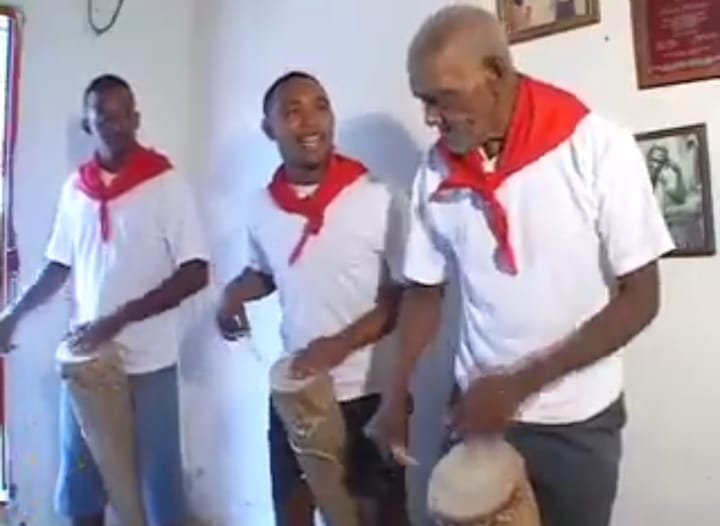
Curiepe Tambores de Libertad. Madera Presenta.Curiepe Drums of Freedom. Wood Presents.
Estos sonidos rítmicos, se definen como música de origen africano, los cuales han pasado por etapas para alcanzar el reconocimiento y aceptación (aunque desvirtuados muchas veces en sus caracteres). Con el boom migratorio petrolero, la cultura también migró y se ubicó en zonas hoy reconocidas como asentamientos afros capitalinos, en el caso de la ciudad capital, provenientes de Barlovento.
These rhythmic sounds are defined as music of African origin, which have gone through stages to achieve recognition and acceptance (although often distorted in their characters). With the oil migratory boom, the culture also migrated and settled in areas today recognized as Afro-Capitalist settlements, in the case of the capital city, coming from Barlovento.
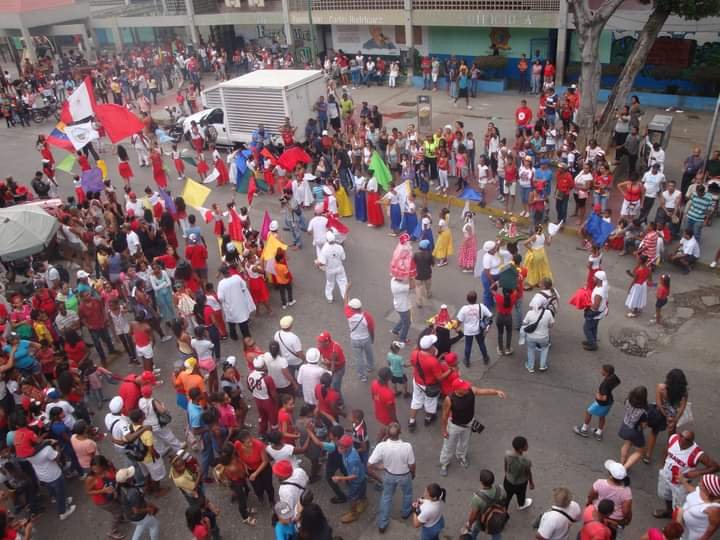
Asentamiento afrodescendiente en Caracas. San Agustin. San Juan. Foto Eilling Blanco.Afro-descendant settlement in Caracas. San Agustin. San Juan. Photo Eilling Blanco.
A ésta vertiente cultural, le llamo Tradicional Costumbrista, ya que se convirtieron en iconos musicales de carácter religioso ancestral con rasgos impuestos del catolicismo, enraizados en comunidades afros como festividades Afrocatólicas, que las caracterizan y las distinguen de otras y como manifestación se arraigó en la cultura y costumbre popular, convirtiéndose así en Tradición, repitiéndose año tras año.
I call this cultural aspect Traditional Costumbrista, since they became musical icons of ancestral religious character with features imposed by Catholicism, rooted in Afro communities as Afro-Catholic festivities, which characterize and distinguish them from others and as a manifestation took root in the culture and popular custom, thus becoming Tradition, repeating year after year.
Los nuevos sonidos y bailes fueron alejándose de sus orígenes dando apertura hacia otros estilos que no poseen la connotación que los ancestrales y afrocatólicos, sino que tienen fines recreativos y contenidos relacionados con la vida cotidiana, del día al día. Los bailes afro que antes eran rechazados comenzaron a verse como expresiones exóticas e incluso bailes de moda: sus ritmos y cantos se incorporaron en los gustos de las personas, sin embargo, lo anterior originó por la masificación en muchos ambientes, que se desvirtuara el significado y carácter original de los mismos, lo cual se evidencia en la pérdida de la cadencia en el baile y de su sincronización con el canto.
In modern times, these dances of the traditional Afro-Catholic music, made inroads into the lower classes of the broad society, who either live in popular settlements or visit the areas in which they occur, this sector of the non-Afro population, also coexist with them in the lower strata.
The new sounds and dances were moving away from their origins, opening up to other styles that do not have the same connotation as the ancestral and Afro-Catholic ones, but have recreational purposes and contents related to daily life, from day to day. Afro dances that were previously rejected began to be seen as exotic expressions and even fashionable dances: their rhythms and songs were incorporated into people's tastes, however, due to the massification in many environments, the original meaning and character of these dances was distorted, which is evident in the loss of cadence in the dance and its synchronization with the song.
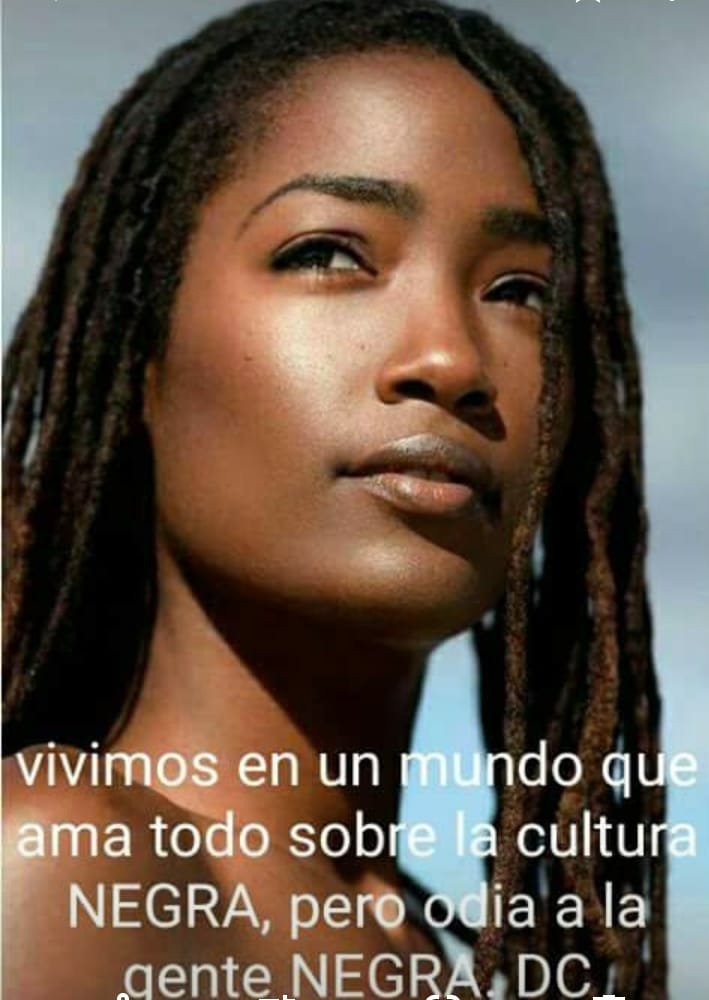
Foto Cortesia del amigo director del Movimiento Afrocolombiano,Lucas Gil.Photo Courtesy of our friend and director of Movimiento Afrocolombiano, Lucas Gil.
Durante el baile afrocatólico barloventeño, en correspondencia con el canto, en varias de sus estrofas, el hombre simula respetuosamente una especie de cortejo a la mujer a la que ésta reacciona de forma cadenciosa y picaresca y al mismo tiempo, evadiéndolo con estilo; en otras estrofas alusivas a la cotidianidad, la pareja, en ocasiones con gestos algo más agitados representa con su danza, el contenido de lo que a través del canto se está expresando…María lava, con jabón, bate que bate, el pantalón; lava que lava, las alpargatas…
During the Afro-Catholic Barloventeño dance, in correspondence with the song, in several of its stanzas, the man respectfully simulates a kind of courtship to the woman to which she reacts in a cadenced and picaresque way and at the same time, evading him with style; in other stanzas alluding to the daily life, the couple, sometimes with more agitated gestures represents with their dance, the content of what is being expressed through the song... María washes, with soap, the pants; she washes the espadrilles...
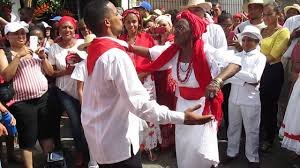
Pareja tradicional de bailadores del culo é puya.cyberspacionline.com.Traditional couple of ass dancers é puya.cyberspacioonline.com.
Las comunidades afrovenezolanas aceptaron las nuevas variables y estilos musicales y durante algún tiempo hubo un cierto vacío tradicional por las formas de penetración comunicacional en las mismas. No obstante dichos asentamientos reaccionaron y comenzaron a reactivarse para priorizar la tradición y vitalizar sus tradiciones y costumbres, como expresiones que se mantienen por la voluntad de sus pueblos de preservar el legado ancestral y definir, de ésta forma su identidad afro. Debido a ese arduo trabajo hoy se consideran parte del folklore venezolano, algunos de ellos considerados por la UNESCO Patrimonio Inmaterial de la Humanidad, tal como los Tambores de San Juan de Curiepe, (la de mayor dimensión y cantidad de seguidores); Los Diablos Danzantes de Yare, La Parranda de San Pedro.
The Afro-Venezuelan communities accepted the new variables and musical styles and for some time there was a certain traditional vacuum due to the forms of communicational penetration in them. However, these settlements reacted and began to reactivate themselves in order to prioritize tradition and vitalize their traditions and customs, as expressions that are maintained by the will of their peoples to preserve the ancestral legacy and define, in this way, their Afro identity. Due to this hard work, today they are considered part of the Venezuelan folklore, some of them considered by UNESCO as Intangible Heritage of Humanity, such as the Drums of San Juan de Curiepe, (the largest in size and number of followers); The Diablos Danzantes de Yare, La Parranda de San Pedro.
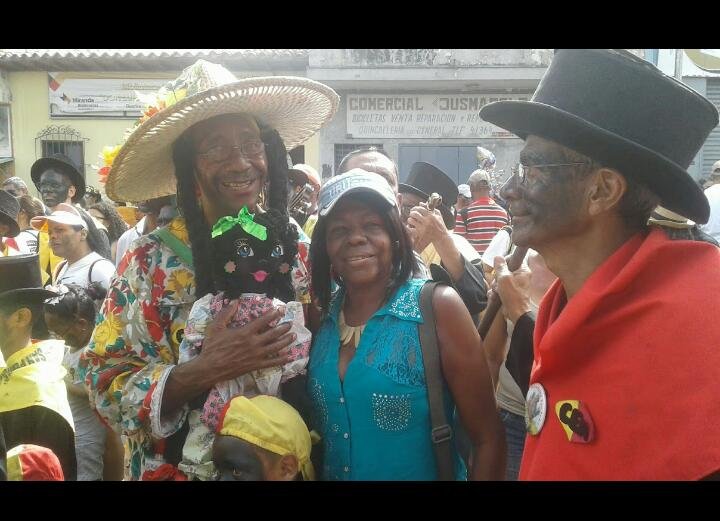
En la Parranda de San Pedro de Guatire con la representación popular de Maria Ignacia. Festividad Afrocatólica.In the Parranda of San Pedro de Guatire with the popular representation of Maria Ignacia. Afro-Catholic Festivity.
Los Tambores representativos en Barlovento son el tambor redondo o culo é puya, el mina, la curbata, el quitiplás y en proceso de rescate y reivindicación, la versión femenina del toque identificado como tambor de agua, que se conserva en el pueblo de Tacariguita.
El tambor redondo o culo é puya, se ha hecho común en varios lugares, pero su significado original e importancia lo encontramos en los Tambores que se ofrendan a San Juan, cada 24 de Junio, en ocasión de su cumpleaños en Curiepe, Mendoza, Tapipa, Caucagua, El Mango, El Clavo, Panaquire, Higuerote, Tacarigua, San José, Tacariguita, entre otros pueblos y caseríos. San Juan se festeja en otros estados, pero diferente al barloventeño.
The representative drums in Barlovento are the round drum or culo é puya, the mina, the curbata, the quitiplás and in process of rescue and vindication, the feminine version of the drum identified as tambor de agua, which is conserved in the town of Tacariguita.
The round drum or culo é puya, has become common in several places, but its original meaning and importance is found in the drums that are offered to San Juan, every June 24, on the occasion of his birthday in Curiepe, Mendoza, Tapipa, Caucagua, El Mango, El Clavo, Panaquire, Higuerote, Tacarigua, San José, Tacariguita, among other towns and villages. San Juan is celebrated in other states, but different from Barloventeño.
“Los culo é puya son una batería de tambores integrada por la prima, de sonido agudo que marca el ritmo musical; el cruzao, de sonido más grave, también lleva el ritmo con la prima; el pujao con un sonido más grave, con ritmo improvisado entre los dos anteriores”. Remigio “Memo” Piñate, percusionista barloventeño de talla internacional, Integrante del Grupo Madera y tallerista en el maderita.
"The culo é puya is a drum kit made up of the prima, with a high-pitched sound that sets the musical rhythm; the cruzao, with a deeper sound, also carries the rhythm with the prima; the pujao with a deeper sound, with an improvised rhythm between the two previous ones". Remigio "Memo" Piñate, percussionist from Barloventeño of international stature, member of Grupo Madera and workshop leader at Maderita.
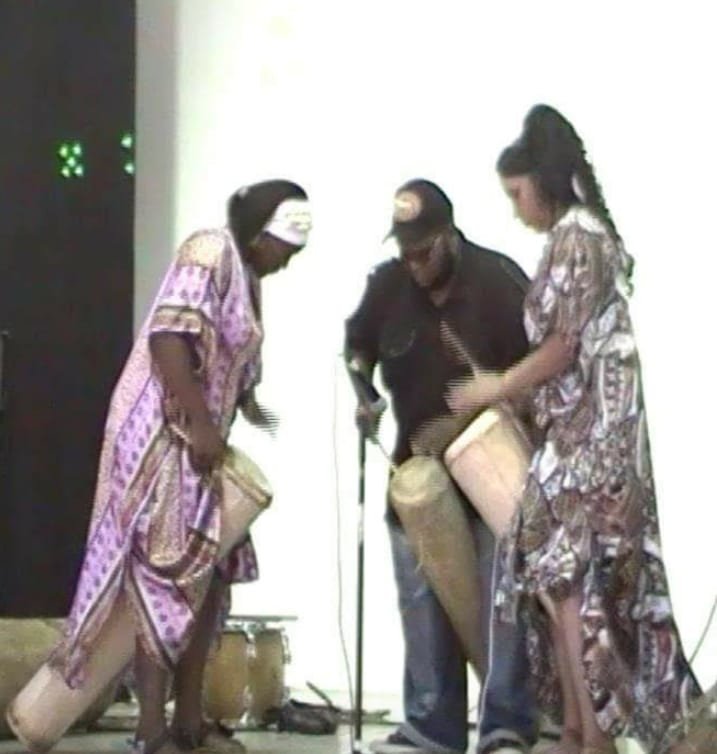
Tambores culo é puya, ejecutados por mujeres de Afrotambor Panaquire y el invitado especial de Dominicana Otoniel Nicolas. En el FIPBAR, Festibal Internacional de la Percusión en Barlovento, de Joel "Pibo" Márquez.Tambores culo é puya, performed by women of Afrotambor Panaquire and special guest from Dominicana Otoniel Nicolas. At the FIPBAR, Festibal Internacional de la Percusión en Barlovento, by Joel "Pibo" Márquez.
El mina es un tambor de cuerpo cilíndrico, largo, que se toca con repiques de palos colocado en dirección diagonal con respecto al piso y es acompañado por la curbata de cuerpo mucho más pequeño y se ejecuta de manera vertical con palos para marcar el ritmo. Con el repique del mina, es cuando los curieperos se detienen a cantar fulías “tambor y canto” y bailar al Santo, debido a la multitud de personas que asisten a Curiepe y retringen el desplazamiento de la procesión, se colocan en lugares puntuales para animarla y alabarlo durante su recorrido. En otros pueblos se coloca un templete cerca de la casa de la familia que le correspondió o solicitó organizar la festividad al Santo, alrededor del cual muchas personas se agrupan para realizar sus rezos, cantos y bailes al son de la curbata y el taqui taqui de la mina. El mina se baila por grupos de personas abrazadas formando hileras, danzando hacia adelante, hacia atrás, girando hacia ambos lados izquierdo, derecho.
The mina is a long cylindrical body drum, which is played with peals of sticks placed diagonally with respect to the floor and is accompanied by the curbata of much smaller body and is executed vertically with sticks to mark the rhythm. With the ringing of the mina, is when the curieperos stop to sing fulías "tambor y canto" and dance to the Saint, due to the multitude of people who attend Curiepe and retringench the displacement of the procession, they are placed in punctual places to encourage it and praise it during its journey. In other towns a pavilion is placed near the house of the family that organized the festivity to the Saint, around which many people gather to make their prayers, songs and dances to the sound of the curbata and the taqui taqui of the mina. The mina is danced by groups of people hugging each other forming rows, dancing forward, backward, turning to both left and right sides.
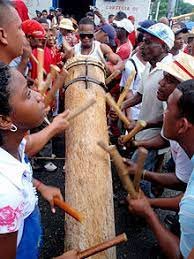
Toque del Mina. mincultura.org.Toque del Mina. mincultura.org.
Del baile de culo é puya y el mina, aún me quedan hermosos recuerdos de mi adolescencia temprana, cuando disfrutaba bailándolos con mi abuelo Máximo alrededor de los templetes en la plaza de Caucagua: disfrutaba y aprendí mucho de él, viéndolo bailar o bailar con él, reconocido como uno de los mejores y con un baile muy bonito, mostraba a través de su baile respeto al Santo y a su pareja o acompañantes, en caso del mina; lo hacía con gran majestuosidad, caballerosidad y cortejo y desplazamiento acompasado. Hoy recuerdo con mucha emoción esos bailes de mi abuelo que todos admiraban y que el bien disfrutaba.
Of the dance of culo é puya and mina, I still have beautiful memories of my early adolescence, when I enjoyed dancing them with my grandfather Máximo around the temples in the square of Caucagua: I enjoyed and learned a lot from him, watching him dance or dancing with him, recognized as one of the best and with a very beautiful dance, he showed through his dance respect to the Saint and his partner or companions, in the case of the mina; he did it with great majesty, chivalry and courtship and rhythmic displacement. Today I remember with great emotion those dances of my grandfather that everyone admired and that he enjoyed very much.
El Quitiplás como instrumento del folclore venezolano de origen africano es típico de Barlovento. Varios tubos de bambú, de distintos tamaño, que producen sonido al ser ejecutados al contacto con el suelo y con las manos”. Remigio “Memo” Piñate.
The Quitiplás as an instrument of Venezuelan folklore of African origin is typical of Barlovento. Several bamboo tubes, of different sizes, that produce sound when played in contact with the ground and with the hands". Remigio "Memo" Piñate.

Toque de Quitiplas en Panaquire, cultor Edwin Gonzalez, foto cortesia Roberto Paez, cultor y cronista de Panaquire.
Toque de Quitiplas in Panaquire, cultor Edwin Gonzalez, photo courtesy of Roberto Paez, cultor and chronicler of Panaquire.
En la misma región de Barlovento, en el puebo Tacariguita, asentamiento afro que la dificultad de acceso le ha permitido conservar parte de su acervo, encontramos el tambor de agua, antes muy común en Barlovento, pero como costumbre prácticamente desaparecida por la incursión de la modernidad a través de conductos directos de agua y aparatos electrodomésticos en este caso, casos lavadoras. El tambor de agua es la versión femenina en la percusión y sonido musical, ejecutado por mujeres cuando iban a los ríos en sus días de faena para lavar ropa. Cuando se reunían un grupo de ellas cantaban mientras realizaban su tarea y producían sonidos rítmicos al chocar la ropa contra el agua. Mi madre me habló mucho de esta práctica en Panaquire, que de joven visualizó muchas veces cuando varias mujeres coincidían lavando en panaquirito o en la cumaca. Este estilo rítmico se conserva en Tacariguita y al igual que los ya mencionados, también rinden para la época homenaje a San Juan, el Santo de los Negros.
In the same region of Barlovento, in the village of Tacariguita, an Afro settlement that the difficulty of access has allowed it to preserve part of its heritage, we find the water drum, once very common in Barlovento, but a custom that has practically disappeared due to the incursion of modernity through direct water conduits and household appliances, in this case, washing machines. The water drum is the feminine version in percussion and musical sound, executed by women when they went to the rivers in their days of labor to wash clothes. When a group of them would gather together they would sing as they went about their task and produce rhythmic sounds as the clothes hit the water. My mother told me a lot about this practice in Panaquire, which as a young girl she visualized many times when several women coincided washing in panaquirito or in the cumaca. This rhythmic style is preserved in Tacariguita and like those already mentioned, they also pay homage to San Juan, the Saint of the Blacks.
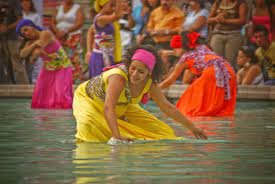
Mujeres ejecutando danza. canto y tambor de agua.Women performing dance, singing and water drum.
Concluyo afirmando que Barlovento geográficamente presenta una rica diversidad de paisajes, fauna, vegetación que la identifica como área turística de gran atractivo, de particularidad económica fundamentada en el cacao y además cuenta con todo ese bagaje musical y cultural que la hace única, para propios y extraños. Una región que bien merece ser atendida y resguardada en todos sus sentidos, para desarrollar y aprovechar de ella todo ese potencial que posee en beneficio de su población y del país, de tal forma que puedan aprovechar sus propios espacios como medios de formación y de trabajo en toda esa diversidad, sin perder el norte de preservar sus manifestaciones sino convirtiéndola en punto referencial, evitando el desplazamiento demográfico hacia otros lugares del país.
I conclude by affirming that Barlovento geographically presents a rich dive
rsity of landscapes, fauna, vegetation that identifies it as a tourist area of great attraction, of economic particularity based on cocoa and also has all that musical and cultural baggage that makes it unique, for locals and strangers. A region that deserves to be taken care of and protected in all its senses, to develop and take advantage of all the potential it has for the benefit of its population and of the country, so that they can take advantage of their own spaces as a means of training and work in all that diversity, without losing the north of preserving its manifestations but becoming a reference point, avoiding the demographic displacement to other parts of the country.
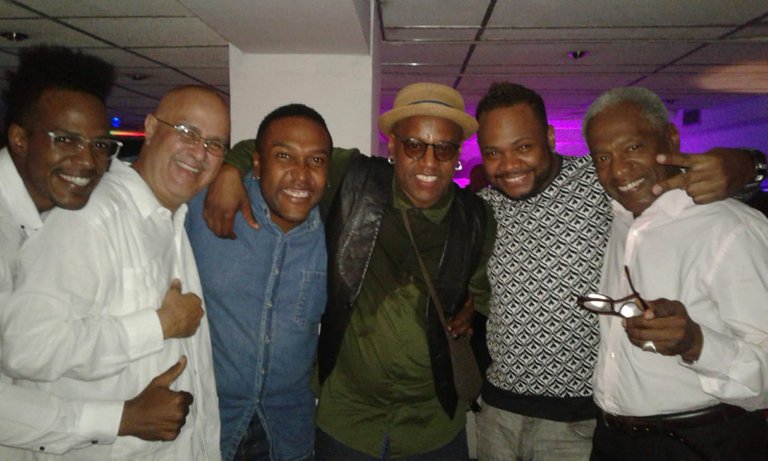
Percusionistas y Cantantes afrovenezolanos. De Barlovento para El Mundo.Afro-Venezuelan Percussionists and Singers. From Barlovento to El Mundo.
Barlovento, Tierra Ardiente y del Tambor.
Barlovento, Tierra Ardiente and del Tambor
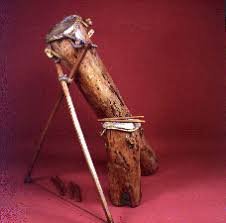
Mina y Curbata Barloventeños.Mina and Curbata Barloventeños.
Africanista Máryori Márquez.Africanist Máryori Márquez.